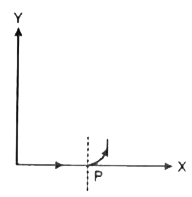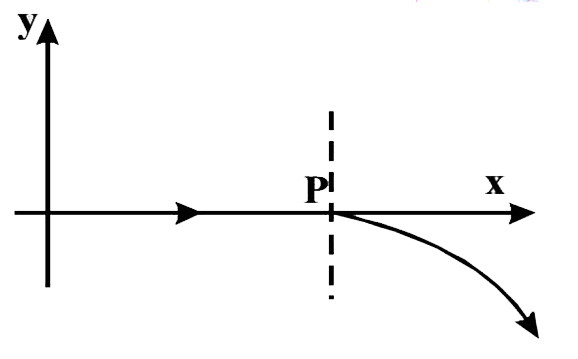An e− is moving in X-Y plane along + ve x-axis . There is a sudden change in its path due to the presence of electric field and/or magnetic field beyond P as shown in fig. The curved path lie in X-Y plane and is found to be non-circular. Which of the following combinations is possible :

→E=0,→B=bˆi+cˆk
→E=aˆi,→B=cˆk+bˆi
→E=0,→B=cˆj+bˆk
→E=aˆi,→B=cˆk+bˆj
The correct Answer is:B
The path of the particle beyond the point P is non circular which is given. Both electric and magnetic fields must be present beyond point P . Since the path of particle lies in x-y plane,
∴ Magnetic field (→B) must be in x-z plane .
Topper's Solved these Questions
- 15 MAGNETIC EFFECTS OF CURRENTSBOOK - MODERN PUBLICATIONCHAPTER - 15 MAGNETIC EFFECTS OF CURRENTSEXERCISE - Multiple choice questions (Level - III)
14 Videos
- 15 MAGNETIC EFFECTS OF CURRENTSBOOK - MODERN PUBLICATIONCHAPTER - 15 MAGNETIC EFFECTS OF CURRENTSEXERCISE - Recent Competitive Questions
31 Videos
- 15 MAGNETIC EFFECTS OF CURRENTSBOOK - MODERN PUBLICATIONCHAPTER - 15 MAGNETIC EFFECTS OF CURRENTSEXERCISE - Multiple choice questions (Level - II)
22 Videos
- ATOMS, MOLECULES AND NUCLEIBOOK - MODERN PUBLICATIONCHAPTER - ATOMS, MOLECULES AND NUCLEIEXERCISE - Recent Competitive Questions
40 Videos
Similar Questions
For a positively charged particle moving in a x−y plane initially along the x-axis , there is a sudden change in its path due to the presence of electric and//or magnetic fields beyond p . The curved path is shown in the x−yplane and is found to be non - circular. Which one of the following combinations is possible ?

View SolutionFor a positively charged particle moving in a x−y plane initially along the x−aξs , there is a sudden change in its path due to the presence of electric and//or magnetic fields beyond p . The curved path is shown in the x−yplane and is found to be non - circular. Which one of the following combinations is possible ?

View Solution
Knowledge Check
For a positively charged particle moving in a x−y plane initially along the x−aξs , there is a sudden change in its path due to the presence of electric and//or magnetic fields beyond p . The curved path is shown in the x−yplane and is found to be non - circular. Which one of the following combinations is possible ?
 A→E=0,→B=bˆi+cˆkB→E=aˆi,→B=cˆk+aˆiC→E=0,→B=cˆj+bˆkD→E=aˆi,→B=bcˆk+bˆj
A→E=0,→B=bˆi+cˆkB→E=aˆi,→B=cˆk+aˆiC→E=0,→B=cˆj+bˆkD→E=aˆi,→B=bcˆk+bˆjAn electron is moving along positive x-axis. To get it moving on an anticlockwise circular path in x-y plane, a magnetic field is applied
Aalong positive y-axisBalong positive z-axisCalong negative y-axisDalong negative z-axisAn electron is moving along positive x-axis. To get it moving on an anticlockwise circular path in x-y plane, a magnetic field is applied
AAlong positive y-axisBAlong positive z-axisCAlong negative y-axisDAlong negative z-axis
In Fig, find the magnetic field at point P. The loop is lying in x-y plane.

View SolutionIn Fig, find the magnetic field at point P. The loop is lying in x-y plane.

View SolutionAn electrons is moving along +ve x-axis in the presence of uniform magnetic field along +ve y-axis. What is the direction of the force acting on it?
View SolutionAn electron is moving along positive x-axis. To get it moving on an anticlockwise circular path in x-y plane, a magnetic field is applied
View SolutionAn electron is moving along positive x-axis. To get it moving on an anticlockwise circular path in x-y plane, a magnetic field is applied
View Solution
